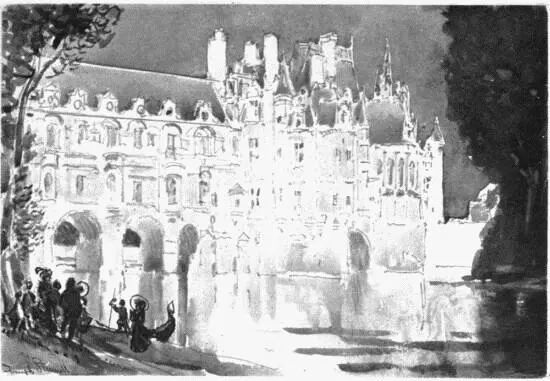Генри Джеймс - A Little Tour of France
Здесь есть возможность читать онлайн «Генри Джеймс - A Little Tour of France» — ознакомительный отрывок электронной книги совершенно бесплатно, а после прочтения отрывка купить полную версию. В некоторых случаях можно слушать аудио, скачать через торрент в формате fb2 и присутствует краткое содержание. Жанр: Путешествия и география, foreign_antique, foreign_prose, на английском языке. Описание произведения, (предисловие) а так же отзывы посетителей доступны на портале библиотеки ЛибКат.
- Название:A Little Tour of France
- Автор:
- Жанр:
- Год:неизвестен
- ISBN:нет данных
- Рейтинг книги:4 / 5. Голосов: 1
-
Избранное:Добавить в избранное
- Отзывы:
-
Ваша оценка:
- 80
- 1
- 2
- 3
- 4
- 5
A Little Tour of France: краткое содержание, описание и аннотация
Предлагаем к чтению аннотацию, описание, краткое содержание или предисловие (зависит от того, что написал сам автор книги «A Little Tour of France»). Если вы не нашли необходимую информацию о книге — напишите в комментариях, мы постараемся отыскать её.
A Little Tour of France — читать онлайн ознакомительный отрывок
Ниже представлен текст книги, разбитый по страницам. Система сохранения места последней прочитанной страницы, позволяет с удобством читать онлайн бесплатно книгу «A Little Tour of France», без необходимости каждый раз заново искать на чём Вы остановились. Поставьте закладку, и сможете в любой момент перейти на страницу, на которой закончили чтение.
Интервал:
Закладка:
Chapter vii
WE never went to Chinon; it was a fatality. We planned it a dozen times; but the weather interfered, or the trains didn't suit, or one of the party was fatigued with the adventures of the day before. This excursion was so much postponed that it was finally postponed to everything. Besides, we had to go to Chenonceaux, to Azay-le-Rideau, to Langeais, to Loches. So I have not the memory of Chinon; I have only the regret. But regret, as well as memory, has its visions; especially when, like memory, it is assisted by photographs. The castle of Chinon in this form appears to me as an enormous ruin, a mediæval fortress of the extent almost of a city. It covers a hill above the Vienne, and after being impregnable in its time is indestructible to-day. (I risk this phrase in the face of the prosaic truth. Chinon, in the days when it was a prize, more than once suffered capture, and at present it is crumbling inch by inch. It is apparent, however, I believe, that these inches encroach little upon acres of masonry.) It was in the castle that Jeanne Dare had her first interview with Charles VII., and it is in the town that François Rabelais is supposed to have been born. To the castle, moreover, the lover of the picturesque is earnestly recommended to direct his steps. But one always misses something, and I would rather have missed Chinon than Chenonceaux. Fortunate exceedingly were the few hours we passed on the spot on which we missed nothing.
"In 1747," says Jean-Jacques Rousseau in his "Confessions," "we went to spend the autumn in Touraine, at the Château of Chenonceaux, a royal residence upon the Cher, built by Henry II. for Diana of Poitiers, whose initials are still to be seen there, and now in possession of M. Dupin, the farmer-general. We amused ourselves greatly at this fine place; the living was of the best, and I became as fat as a monk. We made a great deal of music and acted comedies."
This is the only description that Rousseau gives of one of the most romantic houses in France and of an episode that must have counted as one of the most agreeable in his uncomfortable career. The eighteenth century contented itself with general epithets; and when Jean-Jacques has said that Chenonceaux was a "beau lieu," he thinks himself absolved from further characterisation. We later sons of time have, both for our pleasure and our pain, invented the fashion of special terms, and I am afraid that even common decency obliges me to pay some larger tribute than this to the architectural gem of Touraine. Fortunately I can discharge my debt with gratitude. In going from Tours you leave the valley of the Loire and enter that of the Cher, and at the end of about an hour you see the turrets of the castle on your right, among the trees, down in the meadows, beside the quiet little river. The station and the village are about ten minutes' walk from the château, and the village contains a very tidy inn, where, if you are not in too great a hurry to commune with the shades of the royal favourite and the jealous queen, you will perhaps stop and order a dinner to be ready for you in the evening. A straight, tall avenue leads to the grounds of the castle; what I owe to exactitude compels me to add that it is crossed by the railway-line. The place is so arranged, however, that the château need know nothing of passing trains—which pass, indeed, though the grounds are not large, at a very sufficient distance. I may add that the trains throughout this part of France have a noiseless, desultory, dawdling, almost stationary quality, which makes them less of an offence than usual. It was a Sunday afternoon and the light was yellow save under the trees of the avenue, where, in spite of the waning of September, it was duskily green. Three or four peasants, in festal attire, were strolling about. On a bench at the beginning of the avenue sat a man with two women. As I advanced with my companions he rose, after a sudden stare, and approached me with a smile in which (to be Johnsonian for a moment) certitude was mitigated by modesty and eagerness was embellished with respect. He came toward me with a salutation that I had seen before, and I am happy to say that after an instant I ceased to be guilty of the brutality of not knowing where. There was only one place in the world where people smile like that, only one place where the art of salutation has that perfect grace. This excellent creature used to crook his arm, in Venice, when I stepped into my gondola; and I now laid my hand on that member with the familiarity of glad recognition; for it was only surprise that had kept me even for a moment from accepting the genial Francesco as an ornament of the landscape of Touraine. What on earth—the phrase is the right one—was a Venetian gondolier doing at Chenonceaux? He had been brought from Venice, gondola and all, by the mistress of the charming house, to paddle about on the Cher. Our meeting was affectionate, though there was a kind of violence in seeing him so far from home. He was too well dressed, too well fed; he had grown stout, and his nose had the tinge of good claret. He remarked that the life of the household to which he had the honour to belong was that of a casa regia ; which must have been a great change for poor Checco, whose habits in Venice were not regal. However, he was the sympathetic Checco still; and for five minutes after I left him I thought less about the little pleasure-house by the Cher than about the palaces of the Adriatic.

But attention was not long in coming round to the charming structure that presently rose before us. The pale yellow front of the château, the small scale of which is at first a surprise, rises beyond a considerable court, at the entrance of which a massive and detached round tower, with a turret on its brow (a relic of the building that preceded the actual villa), appears to keep guard. This court is not enclosed—or is enclosed at least only by the gardens, portions of which are at present in process of radical readjustment. Therefore, though Chenonceaux has no great height, its delicate façade stands up boldly enough. This façade, one of the most finished things in Touraine, consists of two storeys, surmounted by an attic which, as so often in the buildings of the French Renaissance, is the richest part of the house. The high-pitched roof contains three windows of beautiful design, covered with embroidered caps and flowering into crocketed spires. The window above the door is deeply niched; it opens upon a balcony made in the form of a double pulpit—one of the most charming features of the front. Chenonceaux is not large, as I say, but into its delicate compass is packed a great deal of history—history which differs from that of Amboise and Blois in being of the private and sentimental kind. The echoes of the place, faint and far as they are to-day, are not political, but personal. Chenonceaux dates, as a residence, from the year 1515, when the shrewd Thomas Bohier, a public functionary who had grown rich in handling the finances of Normandy and had acquired the estate from a family which, after giving it many feudal lords, had fallen into poverty, erected the present structure on the foundations of an old mill. The design is attributed, with I know not what justice, to Pierre Nepveu, alias Trinqueau, the audacious architect of Chambord. On the death of Bohier the house passed to his son, who, however, was forced, under cruel pressure, to surrender it to the Crown in compensation for a so-called deficit in the official accounts of this rash parent and predecessor. Francis I. held the place till his death; but Henry II., on ascending the throne, presented it out of hand to that mature charmer, the admired of two generations, Diana of Poitiers. Diana enjoyed it till the death of her protector; but when this event occurred the widow of the monarch, who had been obliged to submit in silence, for years, to the ascendency of a rival, took the most pardonable of all the revenges with which the name of Catherine de'Medici is associated and turned her out of doors. Diana was not in want of refuges, Catherine went through the form of giving her Chaumont in exchange; but there was only one Chenonceaux. Catherine devoted herself to making the place more completely unique. The feature that renders it sole of its kind is not appreciated till you wander round to either side of the house. If a certain springing lightness is the characteristic of Chenonceaux, if it bears in every line the aspect of a place of recreation—a place intended for delicate, chosen pleasures—nothing can confirm this expression better than the strange, unexpected movement with which, from behind, it carries itself across the river. The earlier building stands in the water; it had inherited the foundations of the mill destroyed by Thomas Bohier. The first step therefore had been taken upon solid piles of masonry; and the ingenious Catherine—she was a raffinée —simply proceeded to take the others. She continued the piles to the opposite bank of the Cher, and over them she threw a long, straight gallery of two tiers. This part of the château, which mainly resembles a house built upon a bridge and occupying its entire length, is of course the great curiosity of Chenonceaux. It forms on each floor a charming corridor, which, within, is illuminated from either side by the flickering river-light. The architecture of these galleries, seen from without, is less elegant than that of the main building, but the aspect of the whole thing is delightful. I have spoken of Chenonceaux as a "villa," using the word advisedly, for the place is neither a castle nor a palace. It is a very exceptional villa, but it has the villa-quality—the look of being intended for life in common. This look is not at all contradicted by the wing across the Cher, which only suggests indoor perspectives and intimate pleasures—walks in pairs on rainy days; games and dances on autumn nights; together with as much as may be of moonlighted dialogue (or silence) in the course of evenings more genial still, in the well-marked recesses of windows.
Читать дальшеИнтервал:
Закладка:
Похожие книги на «A Little Tour of France»
Представляем Вашему вниманию похожие книги на «A Little Tour of France» списком для выбора. Мы отобрали схожую по названию и смыслу литературу в надежде предоставить читателям больше вариантов отыскать новые, интересные, ещё непрочитанные произведения.
Обсуждение, отзывы о книге «A Little Tour of France» и просто собственные мнения читателей. Оставьте ваши комментарии, напишите, что Вы думаете о произведении, его смысле или главных героях. Укажите что конкретно понравилось, а что нет, и почему Вы так считаете.












